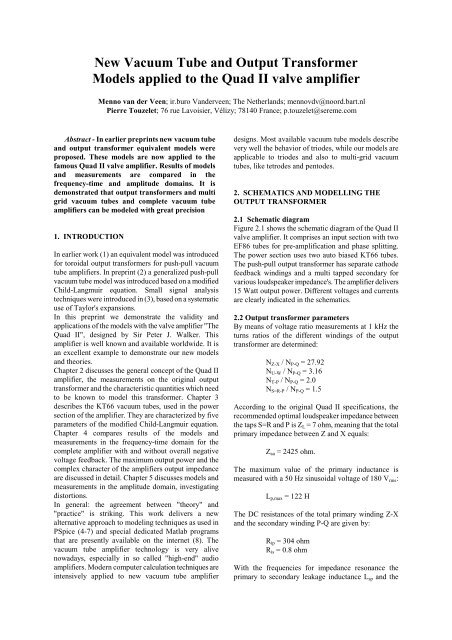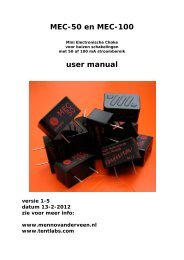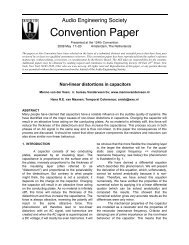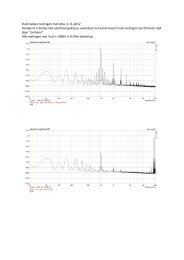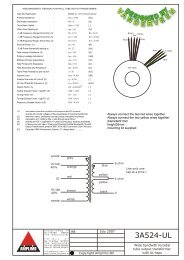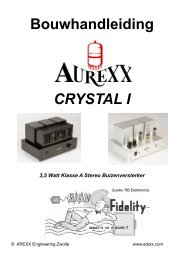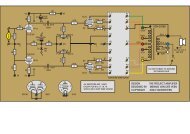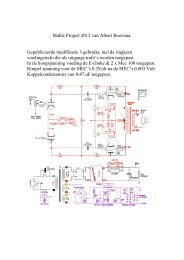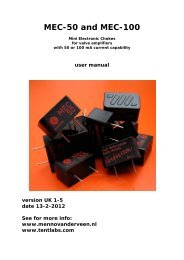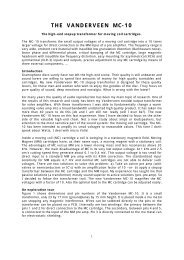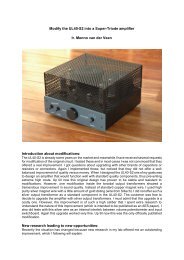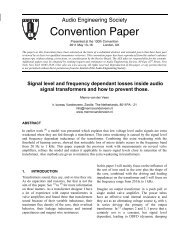Models applied to the Quad II valve amplifier - Menno van der Veen
Models applied to the Quad II valve amplifier - Menno van der Veen
Models applied to the Quad II valve amplifier - Menno van der Veen
You also want an ePaper? Increase the reach of your titles
YUMPU automatically turns print PDFs into web optimized ePapers that Google loves.
New Vacuum Tube and Output Transformer<br />
<strong>Models</strong> <strong>applied</strong> <strong>to</strong> <strong>the</strong> <strong>Quad</strong> <strong>II</strong> <strong>valve</strong> <strong>amplifier</strong><br />
<strong>Menno</strong> <strong>van</strong> <strong>der</strong> <strong>Veen</strong>; ir.buro Van<strong>der</strong>veen; The Ne<strong>the</strong>rlands; mennovdv@noord.bart.nl<br />
Pierre Touzelet; 76 rue Lavoisier, Vélizy; 78140 France; p.<strong>to</strong>uzelet@sereme.com<br />
Abstract - In earlier preprints new vacuum tube<br />
and output transformer equivalent models were<br />
proposed. These models are now <strong>applied</strong> <strong>to</strong> <strong>the</strong><br />
famous <strong>Quad</strong> <strong>II</strong> <strong>valve</strong> <strong>amplifier</strong>. Results of models<br />
and measurements are compared in <strong>the</strong><br />
frequency-time and amplitude domains. It is<br />
demonstrated that output transformers and multi<br />
grid vacuum tubes and complete vacuum tube<br />
<strong>amplifier</strong>s can be modeled with great precision<br />
1. INTRODUCTION<br />
In earlier work (1) an equivalent model was introduced<br />
for <strong>to</strong>roidal output transformers for push-pull vacuum<br />
tube <strong>amplifier</strong>s. In preprint (2) a generalized push-pull<br />
vacuum tube model was introduced based on a modified<br />
Child-Langmuir equation. Small signal analysis<br />
techniques were introduced in (3), based on a systematic<br />
use of Taylor's expansions.<br />
In this preprint we demonstrate <strong>the</strong> validity and<br />
applications of <strong>the</strong> models with <strong>the</strong> <strong>valve</strong> <strong>amplifier</strong> "The<br />
<strong>Quad</strong> <strong>II</strong>", designed by Sir Peter J. Walker. This<br />
<strong>amplifier</strong> is well known and available worldwide. It is<br />
an excellent example <strong>to</strong> demonstrate our new models<br />
and <strong>the</strong>ories.<br />
Chapter 2 discusses <strong>the</strong> general concept of <strong>the</strong> <strong>Quad</strong> <strong>II</strong><br />
<strong>amplifier</strong>, <strong>the</strong> measurements on <strong>the</strong> original output<br />
transformer and <strong>the</strong> characteristic quantities which need<br />
<strong>to</strong> be known <strong>to</strong> model this transformer. Chapter 3<br />
describes <strong>the</strong> KT66 vacuum tubes, used in <strong>the</strong> power<br />
section of <strong>the</strong> <strong>amplifier</strong>. They are characterized by five<br />
parameters of <strong>the</strong> modified Child-Langmuir equation.<br />
Chapter 4 compares results of <strong>the</strong> models and<br />
measurements in <strong>the</strong> frequency-time domain for <strong>the</strong><br />
complete <strong>amplifier</strong> with and without overall negative<br />
voltage feedback. The maximum output power and <strong>the</strong><br />
complex character of <strong>the</strong> <strong>amplifier</strong>s output impedance<br />
are discussed in detail. Chapter 5 discusses models and<br />
measurements in <strong>the</strong> amplitude domain, investigating<br />
dis<strong>to</strong>rtions.<br />
In general: <strong>the</strong> agreement between "<strong>the</strong>ory" and<br />
"practice" is striking. This work delivers a new<br />
alternative approach <strong>to</strong> modeling techniques as used in<br />
PSpice (4-7) and special dedicated Matlab programs<br />
that are presently available on <strong>the</strong> internet (8). The<br />
vacuum tube <strong>amplifier</strong> technology is very alive<br />
nowadays, especially in so called "high-end" audio<br />
<strong>amplifier</strong>s. Mo<strong>der</strong>n computer calculation techniques are<br />
intensively <strong>applied</strong> <strong>to</strong> new vacuum tube <strong>amplifier</strong><br />
designs. Most available vacuum tube models describe<br />
very well <strong>the</strong> behavior of triodes, while our models are<br />
applicable <strong>to</strong> triodes and also <strong>to</strong> multi-grid vacuum<br />
tubes, like tetrodes and pen<strong>to</strong>des.<br />
2. SCHEMATICS AND MODELLING THE<br />
OUTPUT TRANSFORMER<br />
2.1 Schematic diagram<br />
Figure 2.1 shows <strong>the</strong> schematic diagram of <strong>the</strong> <strong>Quad</strong> <strong>II</strong><br />
<strong>valve</strong> <strong>amplifier</strong>. It comprises an input section with two<br />
EF86 tubes for pre-amplification and phase splitting.<br />
The power section uses two au<strong>to</strong> biased KT66 tubes.<br />
The push-pull output transformer has separate cathode<br />
feedback windings and a multi tapped secondary for<br />
various loudspeaker impedance's. The <strong>amplifier</strong> delivers<br />
15 Watt output power. Different voltages and currents<br />
are clearly indicated in <strong>the</strong> schematics.<br />
2.2 Output transformer parameters<br />
By means of voltage ratio measurements at 1 kHz <strong>the</strong><br />
turns ratios of <strong>the</strong> different windings of <strong>the</strong> output<br />
transformer are determined:<br />
NZ-X / NP-Q = 27.92<br />
NU-W / NP-Q = 3.16<br />
NT-P / NP-Q = 2.0<br />
NS=R-P / NP-Q = 1.5<br />
According <strong>to</strong> <strong>the</strong> original <strong>Quad</strong> <strong>II</strong> specifications, <strong>the</strong><br />
recommended optimal loudspeaker impedance between<br />
<strong>the</strong> taps S=R and P is ZL = 7 ohm, meaning that <strong>the</strong> <strong>to</strong>tal<br />
primary impedance between Z and X equals:<br />
Zaa = 2425 ohm.<br />
The maximum value of <strong>the</strong> primary inductance is<br />
measured with a 50 Hz sinusoidal voltage of 180 Vrms:<br />
Lp,max = 122 H<br />
The DC resistances of <strong>the</strong> <strong>to</strong>tal primary winding Z-X<br />
and <strong>the</strong> secondary winding P-Q are given by:<br />
Rip = 304 ohm<br />
Ris = 0.8 ohm<br />
With <strong>the</strong> frequencies for impedance resonance <strong>the</strong><br />
primary <strong>to</strong> secondary leakage inductance Lsp and <strong>the</strong>
effective internal primary capacitance Cip are<br />
determined:<br />
Lsp = 6.4 mH<br />
Cip = 467 pF<br />
The parameters given above determine <strong>the</strong> behavior of<br />
<strong>the</strong> output transformer in <strong>the</strong> frequency domain for a<br />
speaker load of 7 ohm, as explained in full detail in (1).<br />
3 MODELLING THE KT66<br />
3.1 Handbook parameter set<br />
Tube handbooks deliver information about <strong>the</strong> KT66.<br />
The following set of data is used:<br />
S = 6.3 mA/V<br />
rp = 22.5 kohm<br />
Ia0 = 85 mA<br />
Ig20 = 6.3 mA<br />
Vak0 = Vg20 = 250 V<br />
Vg10 = -14.6 V<br />
3.2 Five parameter set<br />
According <strong>to</strong> <strong>the</strong> procedures as described in (2), <strong>the</strong> five<br />
parameter set of <strong>the</strong> KT66 is calculated, resulting in:<br />
[n ; αo ; K ; Da ; Dg2 ] =<br />
[10 ; 0.966 ; 1.003·10 -3 ; 3.619·10 -3 ; 0.136]<br />
The Child-Langmuir equation with its modification α<br />
that belongs <strong>to</strong> <strong>the</strong> five parameter-set is given below:<br />
I<br />
α =<br />
I<br />
I<br />
a<br />
a<br />
k<br />
= α K<br />
2<br />
= [ Arctg (<br />
V<br />
α o<br />
π V<br />
( V<br />
g1k<br />
+ D<br />
g2<br />
V<br />
g2k<br />
ak<br />
g2k<br />
+ D<br />
a<br />
) ]<br />
V<br />
1/n<br />
ak<br />
)<br />
3<br />
2<br />
(3.2.1)<br />
3.3 Initial test of <strong>the</strong> new parameter set<br />
A quick initial test is possible about <strong>the</strong> validity of <strong>the</strong><br />
equation 3.2.1 plus <strong>the</strong> five parameter set, by using <strong>the</strong><br />
voltages and currents in <strong>the</strong> quiescent operating point as<br />
given in <strong>the</strong> schematic diagram of <strong>the</strong> <strong>Quad</strong> <strong>II</strong> <strong>amplifier</strong>.<br />
The voltage at <strong>the</strong> cathode (tap V) equals Vk0 = 26 V.<br />
Then Vak0 = 340 - 26 = 314 V and Vg2k0 = 330 - 26 =<br />
304 V. The anode current equals Ia0 = 65 mA. With<br />
formula 3.2.1 <strong>the</strong> control grid voltage Vg1k0 can be<br />
calculated: Vg1k0 = -25,2 V, which only deviates 3% of<br />
Vk0 = 26 V. Because [ Ik0 = Ia0 + Ig20 ] <strong>the</strong> calculated<br />
screen grid current equals Ig20 = 7 mA as shown in <strong>the</strong><br />
diagram.<br />
4 SMALL SIGNAL TRANSFER FUNCTION<br />
4.1 Effective plate resistance of <strong>the</strong> KT66<br />
Through <strong>the</strong> cathode windings at <strong>the</strong> output transformer<br />
an amount Γ = NU-W / NZ-X = 0.11 of negative voltage<br />
feedback is <strong>applied</strong> at <strong>the</strong> cathode of each KT66. In <strong>the</strong><br />
<strong>Quad</strong> <strong>II</strong> circuit <strong>the</strong>re is no feedback at <strong>the</strong> screen grids,<br />
so X = 0. Using <strong>the</strong> new coupling model of (2), <strong>the</strong><br />
effective plate resistance of each KT66 tube can be<br />
calculated, resulting in:<br />
rp,eff = 2 ri,eff = 1171 ohm<br />
The <strong>to</strong>tal primary winding of <strong>the</strong> output transformer is<br />
driven by two tubes. In (2) this circuit is represented by<br />
a single voltage source with an effective genera<strong>to</strong>r<br />
resistance Rgen,eff driving <strong>the</strong> <strong>to</strong>tal primary winding, with<br />
Rgen,eff = 2 rp,eff = 2342 ohm<br />
Again a quick initial test of this result is possible, by<br />
calculating and measuring at 1 kHz <strong>the</strong> output<br />
impedance Zout at <strong>the</strong> speaker terminals, when no<br />
overall negative voltage feedback is <strong>applied</strong> (R11 is<br />
temporally removed):<br />
N<br />
= [<br />
N<br />
2<br />
] . ( R<br />
+ R<br />
) + R<br />
Zout S-P<br />
Z-X<br />
gen, eff ip is<br />
(4.1.1)<br />
The calculated value of Zout equals 8.5 ohm, while <strong>the</strong><br />
measured value is 7.9 ohm (at 1 kHz sine wave and 2.8<br />
Vrms at speaker terminals). These values differ 6.7%,<br />
which is consi<strong>der</strong>ed <strong>to</strong> be a negligible difference, taking<br />
aging and deviations in specifications of tubes in<strong>to</strong><br />
account.<br />
Looking more precise in<strong>to</strong> this, <strong>the</strong>re appears <strong>to</strong> be<br />
ano<strong>the</strong>r effect. Using <strong>the</strong> Tailor expansions of (3), <strong>the</strong><br />
value of ri,eff can be calculated as function of <strong>the</strong><br />
alternating voltage at <strong>the</strong> control grids of <strong>the</strong> KT66<br />
tubes. Figure 4.1 shows <strong>the</strong> result. At higher alternating<br />
voltages <strong>the</strong> genera<strong>to</strong>r resistance becomes larger, which<br />
easily can be explained consi<strong>der</strong>ing <strong>the</strong> descending<br />
slope of <strong>the</strong> Ia-Vak characteristics of <strong>the</strong> KT66 tube at<br />
higher control grid voltages.<br />
4.2 Transfer Function of power section<br />
In (1) is explained how <strong>to</strong> calculate <strong>the</strong> transfer function<br />
of <strong>the</strong> two KT66 tubes combined with <strong>the</strong> output<br />
transformer. The primary inductance Lp,max of <strong>the</strong><br />
transformer, combined with <strong>the</strong> effective plate<br />
resistance of <strong>the</strong> tubes create a first or<strong>der</strong> high pass filter<br />
with -3dB frequency f-3L:<br />
f-3L = 1.55 Hz<br />
At high frequencies Lsp and Cip create a second or<strong>der</strong><br />
low pass filter with central frequency fo and Q-fac<strong>to</strong>r:<br />
fo = 131 kHz<br />
Q = 1 / a2 = 0.664
The normalized transfer function H1(f) of <strong>the</strong> KT66<br />
tubes and <strong>the</strong> output transformer is shown in formula<br />
4.2.1 (j = sqrt(-1)):<br />
j.f<br />
H 1(f)<br />
=<br />
j.f + f<br />
-3L<br />
.<br />
1 +<br />
1<br />
Q<br />
1<br />
j.f<br />
. + (<br />
f<br />
o<br />
j.f<br />
f<br />
o<br />
)<br />
2<br />
(4.2.1)<br />
4.3 Transfer Function of <strong>the</strong> EF86 section<br />
The input-driver section with <strong>the</strong> two EF86 tubes<br />
contains two filters. The first is a high pass filter, first<br />
or<strong>der</strong>, created by <strong>the</strong> coupling capaci<strong>to</strong>rs C2 and C3<br />
plus <strong>the</strong> resis<strong>to</strong>rs R7 and R9. Its -3dB frequency is<br />
given by:<br />
fC2,3-L = 1.85 Hz<br />
The second filter is created by <strong>the</strong> 'large' output<br />
impedance of <strong>the</strong> EF86 tubes and <strong>the</strong>ir 'large' anode<br />
resistances R5 and R6, combined with <strong>the</strong> Miller<br />
capacitance's at <strong>the</strong> control grids of <strong>the</strong> KT66 power<br />
tubes. Its -3dB first or<strong>der</strong> low pass frequency is given<br />
by:<br />
fEF86-H = 7.5 kHz<br />
The normalized transfer function H2(f) of <strong>the</strong> EF86<br />
section is given in formula 4.3.1.<br />
j.f<br />
H 2 (f) =<br />
j.f + f<br />
C2,3-L<br />
f<br />
.<br />
j.f + f<br />
EF86-H<br />
EF86-H<br />
(4.3.1)<br />
4.4 Transfer Function of <strong>the</strong> complete <strong>amplifier</strong><br />
Without feedback in <strong>the</strong> <strong>amplifier</strong> (R11 temporally<br />
removed) and without a loudspeaker connected <strong>to</strong> <strong>the</strong><br />
speaker terminals, <strong>the</strong> voltage amplification A0 at 1 kHz<br />
is measured from input <strong>to</strong> output:<br />
A0 = 100<br />
The transfer function A0(f) of <strong>the</strong> <strong>to</strong>tal <strong>amplifier</strong>,<br />
unloaded at <strong>the</strong> output, is given by formula 4.4.1 and<br />
shown in <strong>the</strong> upper curve of figure 4.4.1:<br />
(f) = A0<br />
. H 1(f)<br />
. H (f)<br />
A0 2<br />
(4.4.1)<br />
With R11 connected, <strong>the</strong> effective feedback fac<strong>to</strong>r β<br />
with respect <strong>to</strong> <strong>the</strong> 7 ohm tap S=R is given by:<br />
β = NP-Q / NP-S R10 / (R10 + R11)<br />
β = 0.117<br />
The effective transfer function of <strong>the</strong> complete<br />
<strong>amplifier</strong>, with negative voltage feedback and loaded by<br />
a loudspeaker ZL is given by formula 4.4.2:<br />
A<br />
eff, L<br />
A0<br />
(f) Z L<br />
(f) = .<br />
1+<br />
β . A0<br />
(f) Z out<br />
+ Z L<br />
1+<br />
β . A0<br />
(f)<br />
(4.4.2)<br />
The two lower curves in figure 4.4.1 show <strong>the</strong> result of<br />
<strong>the</strong> calculation with formula 4.4.2 and <strong>the</strong> measurement<br />
with ZL = 7 ohm. The agreement is striking. Only at <strong>the</strong><br />
highest frequencies some partial resonance's appear in<br />
<strong>the</strong> EI-core output transformer of <strong>the</strong> <strong>Quad</strong> <strong>II</strong> <strong>amplifier</strong>,<br />
which are no part of <strong>the</strong> modeling of a <strong>to</strong>roidal core<br />
output transformer in (1).<br />
The calculated transfer at low frequencies with feedback<br />
shows a maximum while <strong>the</strong> measurements show a<br />
gentle roll off, see figure 4.4.1. This deviation can be<br />
explained with <strong>the</strong> assumption that is made in <strong>the</strong><br />
calculation:<br />
The frequency f-3L is calculated with <strong>the</strong> maximum<br />
value LP,max. However, at small and mo<strong>der</strong>ate AC output<br />
levels, <strong>the</strong> actual value of LP will be smaller (up <strong>to</strong> 10<br />
times) than LP,max. Consequently f-3L will be larger than<br />
<strong>the</strong> given value of 1.55 Hz. Implementing such a larger<br />
f-3L value in<strong>to</strong> <strong>the</strong> calculation causes <strong>the</strong> maximum <strong>to</strong><br />
disappear. Then measurements and calculation are in<br />
full agreement again. See figure 4.4.2.<br />
There is one peculiar condition where this maximum<br />
can be noticed: "switch <strong>the</strong> <strong>amplifier</strong> off while listening<br />
<strong>to</strong> music". Then <strong>the</strong> sound level will decrease 'swinging'<br />
in loudness with a swing-frequency equal <strong>to</strong> <strong>the</strong><br />
frequency of <strong>the</strong> calculated maximum. But who listens<br />
<strong>to</strong> an <strong>amplifier</strong> while switching <strong>the</strong> power off?<br />
4.5 Output impedance<br />
The output impedance Zout,eff of <strong>the</strong> complete <strong>amplifier</strong><br />
at a small signal output level is given by formula 4.4.3.<br />
Z<br />
out, eff<br />
(f) =<br />
1+<br />
Z out<br />
β . A<br />
0<br />
(f)<br />
(4.4.3)<br />
This formula shows that this output impedance is a<br />
complex function, <strong>the</strong>refore |Zout,eff(f)| is shown in figure<br />
4.5.<br />
4.6 Voltages, Currents and Powers<br />
Figure 4.6.1 shows <strong>the</strong> calculated anode and screen grid<br />
currents per KT66 tube as function of <strong>the</strong> momentary<br />
anode voltage. With <strong>the</strong>se data <strong>the</strong> output power Pout,<br />
<strong>the</strong> anode dissipation Pa and <strong>the</strong> screen grid dissipation<br />
Pg2 can be calculated as function of <strong>the</strong> alternating<br />
control grid voltage. The results are shown in figure<br />
4.6.2. The calculations show a maximum output power
of 18 W, while 15 W is measured. The difference can<br />
be explained and calculated taking <strong>the</strong> transformer<br />
winding resistances Rip and Ris in<strong>to</strong> account, which<br />
cause insertion loss inside <strong>the</strong> output transformer.<br />
5 DISTORTIONS<br />
5.1 Harmonic dis<strong>to</strong>rtions without feedback<br />
In (3) <strong>the</strong> procedure is explained how <strong>to</strong> calculate<br />
harmonic dis<strong>to</strong>rtions, using <strong>the</strong> Taylor expansions.<br />
Figure 5.1 shows <strong>the</strong> results of <strong>the</strong> calculated dis<strong>to</strong>rtions<br />
at 1 kHz only in <strong>the</strong> section of KT66 tubes plus output<br />
transformer. No overall feedback is <strong>applied</strong> nor any<br />
influence of <strong>the</strong> EF86 vacuum tubes nor transformer<br />
dis<strong>to</strong>rtions are taken in<strong>to</strong> account. It is striking that <strong>the</strong>re<br />
is no 2nd harmonic dis<strong>to</strong>rtion, which is a direct<br />
consequence of <strong>the</strong> push-pull concept.<br />
5.2 Harmonic dis<strong>to</strong>rtions with feedback<br />
Applying overall negative feedback, <strong>the</strong> THD-figures of<br />
figure 5.1 get smaller by <strong>the</strong> fac<strong>to</strong>r of 1 / (1+ βA0).<br />
Figure 5.2 shows <strong>the</strong> calculated results plus measured<br />
harmonic dis<strong>to</strong>rtions at <strong>the</strong> actual <strong>amplifier</strong>.<br />
The second harmonic dis<strong>to</strong>rtion is not zero, as<br />
calculated. The measured third harmonic dis<strong>to</strong>rtion<br />
appears <strong>to</strong> be 10 times larger than <strong>the</strong> calculated<br />
dis<strong>to</strong>rtion.<br />
These deviations mainly are caused by not modeling <strong>the</strong><br />
EF86 circuitry nor taking output transformer behavior<br />
in<strong>to</strong> account.<br />
The EF86 circuit can be modeled in <strong>the</strong> same way as <strong>the</strong><br />
KT66 vacuum tubes, however was not done in this<br />
preprint.<br />
The output transformer dis<strong>to</strong>rtions are subject of present<br />
research and modeling, taking <strong>the</strong> real dynamic B-H<br />
relation of actual cores in<strong>to</strong> account.<br />
In general about dis<strong>to</strong>rtions: only if <strong>the</strong> complete<br />
<strong>amplifier</strong> is modeled, real calculations can be performed<br />
with better precision. At this moment we are not ready<br />
<strong>to</strong> show such results.<br />
6 CONCLUSIONS<br />
The output transformer of a push-pull vacuum tube<br />
<strong>amplifier</strong> can be modeled with a simple equivalent<br />
circuit as proposed in (1).<br />
A multi grid vacuum tube can be modeled with <strong>the</strong><br />
modified Child-Langmuir equation as proposed in (2)<br />
and (3). The model replaces <strong>the</strong> vacuum tubes in a<br />
push-pull <strong>amplifier</strong> by an equivalent circuit, consisting<br />
of a single voltage source with series genera<strong>to</strong>r<br />
resistance. This resistance appears <strong>to</strong> be not constant<br />
and depends on <strong>the</strong> momentary voltages at <strong>the</strong> tube.<br />
The output impedance of a push-pull <strong>amplifier</strong> can be<br />
calculated taking vacuum tube genera<strong>to</strong>r resistance and<br />
output transformer specifications in<strong>to</strong> account. There is<br />
good agreement between calculations and measurement.<br />
In <strong>the</strong> frequency domain <strong>the</strong> transfer function of<br />
modeled tubes and output transformer can be calculated<br />
with good precision. Only small partial high frequency<br />
resonance's are not modeled.<br />
The established <strong>the</strong>ories of overall negative voltage<br />
feedback are proven once again in this work.<br />
The new vacuum tube and output transformer models<br />
allow precise calculation of <strong>amplifier</strong>s output power,<br />
power loss inside <strong>the</strong> output transformer, as well as heat<br />
dissipations at screen grid and anode of each power<br />
tube.<br />
Harmonic dis<strong>to</strong>rtions of a complete push-pull vacuum<br />
tube <strong>amplifier</strong> can be calculated, although this<br />
procedure has not yet been completed. Especially a new<br />
model of <strong>the</strong> output transformer needs fur<strong>the</strong>r work,<br />
taking real B-H behavior inside <strong>the</strong> core in<strong>to</strong> account.<br />
It really is amazing, after so many years of <strong>the</strong> design<br />
date of <strong>the</strong> <strong>Quad</strong> <strong>II</strong> <strong>amplifier</strong> (approx. 1950), <strong>to</strong> notice<br />
that present computer modeling again proves <strong>the</strong><br />
excellent and sound qualities of this famous <strong>amplifier</strong>.<br />
7 REFERENCES<br />
1: <strong>Menno</strong> <strong>van</strong> <strong>der</strong> <strong>Veen</strong>: "Theory and Practice of Wide<br />
Bandwidth Toroidal Output Transformers"; preprint<br />
3887, AES convention 1994 November San Francisco<br />
2: <strong>Menno</strong> <strong>van</strong> <strong>der</strong> <strong>Veen</strong>: "Modeling Power Tubes and<br />
<strong>the</strong>ir Interaction with Output Transformers"; preprint<br />
4643, AES convention 1998 May Amsterdam<br />
3: Pierre Touzelet, <strong>Menno</strong> <strong>van</strong> <strong>der</strong> <strong>Veen</strong>: "Small Signal<br />
Analysis for generalized push-pull tube <strong>amplifier</strong><br />
<strong>to</strong>pology"; preprint 5587, AES convention 2002 May<br />
Munich<br />
4: W. Marshall Leach Jr.: "Spice models for<br />
vacuum-tube <strong>amplifier</strong>s"; JAES Vol 43/3; 1995 March<br />
5: Scott Reynolds: "Vacuum-tube models for Pspice<br />
simulations"; Glass Audio; Vol 5/4 1993<br />
6: Eric Pritchard: "Tube model critique"; Glass Audio;<br />
Vol 8/1 1996<br />
7: Norman Koren: "Improved Vacuum-tube models for<br />
Spice simulations"; Glass Audio; Vol 8/5 1996<br />
8: Eugene V. Karpov: good starting address for<br />
internet search: www.next-power.net/next-tube.html
E ffective internal im pedance Ohm<br />
700<br />
650<br />
600<br />
550<br />
Figure 2.1: Schematic Diagram of <strong>the</strong> <strong>Quad</strong> <strong>II</strong> Valve Amplifier<br />
K T 66 - Vaà=314 Volt - Vg20=304 Volt - Vg10=-25,2 Volt - Z a=613 Ohm<br />
500<br />
0 10 20 30 40<br />
Input signal e Volt<br />
Figure 4.1: Effective impedance ri,eff as function of <strong>the</strong> alternating KT66 control grid voltage
Ao i<br />
42<br />
Aeff i<br />
Am j<br />
Ao i<br />
0<br />
42<br />
Aeff i<br />
0<br />
20<br />
Zeff i<br />
0<br />
40<br />
20<br />
0<br />
40<br />
20<br />
.1 f i f 0.1 1 10 100 1 10<br />
, , f<br />
i j<br />
3<br />
Figure 4.4.1: Transfer functions in dB: upper curve is <strong>the</strong> calculation without NFB;<br />
lower curves are measurements and calculation with NFB<br />
10 6<br />
1 10 6<br />
0<br />
0.1 1 10 100<br />
.1 f , f<br />
i i<br />
100<br />
Figure 4.4.2: Transfer function in dB: upper curve is calculation without NFB for Lp,max =12,2 H;<br />
<strong>the</strong> lower curve is calculated with NFB.<br />
20<br />
10<br />
0<br />
.1 f 0.1 1 10 100 1 10<br />
i<br />
3<br />
Figure 4.5: Effective output impedance (absolute value) of <strong>the</strong> <strong>amplifier</strong> with NFB for Lp = Lp,max.<br />
1 10 4<br />
1 10 4<br />
1 10 5<br />
1 10 5<br />
10 6<br />
1 10 6
Ia i<br />
Ig2 i<br />
Pa p<br />
Figure 4.6.1: Anode current (upper curve) and Screen Grid Current (lower curve) per KT66<br />
as function of <strong>the</strong> momentary anode voltage. The middle of <strong>the</strong> x-axis is <strong>the</strong> quiescent operating point.<br />
30<br />
Puit p<br />
Pg2 p<br />
.3<br />
0<br />
0 Va<br />
i<br />
0<br />
0 p<br />
2. Va0<br />
Figure 4.6.2: Anode dissipation per KT66 (upper curve); output power (middle curve);<br />
screen grid dissipation per KT66 (lower curve),<br />
as function of <strong>the</strong> control grid voltage (arbitrary unit)<br />
5
Harmonic dis<strong>to</strong>rtion %<br />
0,2<br />
0,15<br />
0,1<br />
0,05<br />
0<br />
0 10 20<br />
Input voltage e Volt<br />
30 40<br />
.2<br />
T3m%<br />
j<br />
T3c% . 10<br />
j<br />
T2m% j<br />
KT66 - Va0=314 Volt - Vg20=304 Volt - Vg10=-25,2 Volt - Za=613 Ohm<br />
H2% H3% H4% H5%<br />
Figure 5.1: Calculated harmonic dis<strong>to</strong>rtions in KT66's plus OPT section<br />
assuming no THD in <strong>the</strong> OPT and no NFB<br />
0<br />
0 ein<br />
j<br />
Figure 5.2: Harmonic Dis<strong>to</strong>rtion (%) at 1kHz as function of <strong>the</strong> KT66 control grid voltage<br />
with overall negative feedback:<br />
2-nd harmonic dis<strong>to</strong>rtion (measured, upper curve);<br />
3-rd harmonic dis<strong>to</strong>rtion (measured, 2-nd curve);<br />
3-rd harmonic dis<strong>to</strong>rtion times 10 (calculated, 3-rd curve).<br />
30


